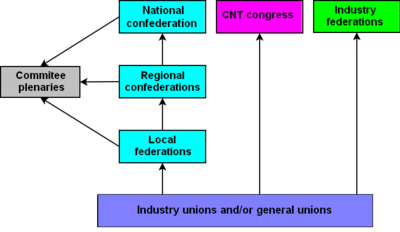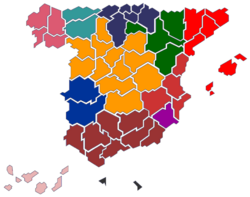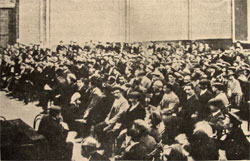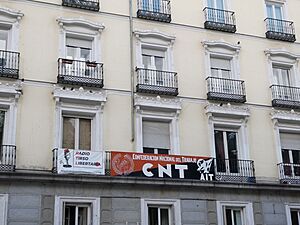Confederación Nacional del Trabajo facts for kids
|
Confederación Nacional del Trabajo
|
|
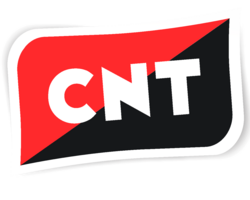
CNT logo, since 2021
|
|
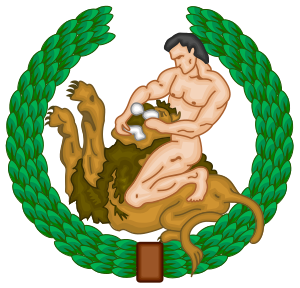
CNT emblem
|
|
| Abbreviation | CNT |
|---|---|
| Predecessor | Workers' Solidarity |
| Established | 1 November 1910 |
| Type | National trade union confederation |
| Headquarters | Carrer Emili Botey Alsina, 14, Granollers (location changes with the General Secretary) |
| Location | |
|
Membership (2018)
|
5,000 |
|
General Secretary
|
Erika Conrado |
| Affiliations |
|
The Confederación Nacional del Trabajo (CNT), which means "National Confederation of Labor," is a Spanish trade union group. It is known for its anarcho-syndicalism ideas. This means it's a union that believes workers should manage themselves and aims for a society without a government, where workers control everything.
The CNT was started in 1910 in Barcelona. It grew from groups that were part of another union called Solidaridad Obrera. The CNT helped spread the ideas of anarchism in Spain. Even though it was made illegal many times in Spain's history, the CNT still works to help Spanish workers. It focuses on ideas like workers' self-management (workers running things themselves), federalism (different groups working together while staying independent), and mutual aid (people helping each other).
For a long time, the CNT was part of the International Workers' Association (AIT). But in 2018, the CNT and other unions created a new group called the International Confederation of Labour (ICL-CIT).
Contents
How the CNT Works
The CNT welcomes many people to join. They say, "We don't make special rules for who can join. You just need to be a worker or a student, whether you have a job or not." However, people who work for police, military, or security, or are employers, cannot join.
The main goals of the CNT are to:
- Help workers feel connected and support each other.
- Improve working conditions for everyone.
- Prepare workers to take control of their workplaces in the future.
- Encourage mutual aid among CNT groups.
- Work with other groups that want to help all workers.
The CNT also wants to make big changes to society, not just for workers. They aim for a social revolution to create a society based on anarchist communism. This is a set of ideas for how an anarchist society could be organized. The CNT gets its ideas from anarchism and supports other social movements. The CNT believes in working with people from all over the world, but also supports communities being able to make their own decisions without a powerful government.
The CNT has three main beliefs:
- Workers' self-management (autogestión): Workers manage their own jobs and workplaces.
- Federalism: Different groups work together but keep their independence.
- Mutual aid: People help each other out.
The CNT believes that problems between bosses and workers should be solved directly by them. They don't think government groups or professional union leaders should get involved. Because of this, the CNT doesn't usually take part in union elections or use official works councils. Instead, they prefer workers' meetings, union groups, and direct action (workers taking action themselves). They also try to avoid going to court. People who hold leadership roles in the union are not paid and their positions change regularly.
Structure of the CNT
The CNT is organized using direct democracy. This means that decisions are made directly by the members, not by a few leaders.
The basic parts of the CNT are the industrial unions. These unions bring together workers from different jobs within the same industry. If there are fewer than 25 workers in one industry, they form a "various posts union." This union can include workers from different jobs and industries. It needs at least five people. If there are fewer than five, they can form a "confederal group." Since the CNT is not very large, most of its unions are "various posts unions."
Decisions in these unions are made by the union assembly. This is a meeting where all the workers in that union discuss and agree on things. They use a system of direct democracy and try to reach consensus, where everyone agrees. These meetings can talk about any issue, whether it's local, regional, or national.
Unlike many organizations that are run from the top down, the CNT is organized from the bottom up. This is called an "anarchistic" way of organizing. It helps make sure that committees don't become too powerful or have their own political ideas. It also limits the power of any single person in the organization.
All the different unions in a city or town form a local federation. These are coordinated by a local committee. This committee is chosen in a local meeting where each union can send representatives. The CNT has local federations in cities like Madrid, Barcelona, Granada, and Seville.
Representatives from the local unions also attend the CNT Congress. They bring ideas and agreements from their own union meetings. The Congress decides on the CNT's overall plan and can choose new National Committees. The first Congress was held in September 1911, a year after the CNT started.
The CNT also has its own media. Solidaridad Obrera ("Workers' Solidarity") is a newspaper from the Catalonia region. It started in 1907 and is the oldest CNT publication. Other media include La tira de papel, Cenit, and BICEL.
How Voting Works
The CNT usually tries to make decisions by consensus, where everyone agrees, instead of voting. They believe this fits better with their anarchist principles. While small unions can often reach full consensus, larger groups sometimes need to vote. When they do, it's always done openly by a show of hands.
The CNT uses a special system for voting to try and be fair. It's called "limited proportional voting." This system tries to give a voice to both small and large unions. Even with this system, there can be some challenges, especially for very large unions. However, the CNT believes that after a lot of discussion, agreements usually reach a point where most people are happy.
History of the CNT
Early Years
The CNT was founded in 1910 in Barcelona. Its goal was to be a strong union against the larger socialist union, UGT. It also wanted to help workers gain economic freedom. When it started, the CNT had about 26,571 members. In 1911, after its first meeting, the CNT organized a general strike. This led a judge in Barcelona to declare the union illegal.
After 1918, the CNT grew much stronger. This made employers worried, and some hired people to threaten union members. This led to a lot of violence. The CNT played a big part in the 1919 general strike at La Canadiense, which stopped 70% of factories in Catalonia. By that year, the CNT had 700,000 members. In 1922, the CNT joined the International Workingmen's Association (later called the International Workers' Association). But the next year, when Miguel Primo de Rivera became dictator, the union was made illegal again.
In 1927, some CNT members who were more moderate created the Federación Anarquista Ibérica (FAI) in Valencia. The FAI was a group of anarchist clubs. The FAI helped keep the CNT focused on its anarchist ideas, and its influence continues today.
The Second Spanish Republic
When the monarchy fell in 1931 and the Second Spanish Republic began, the CNT gave it little support. This support decreased over time because the CNT often clashed with the government through strikes, like the 1931 Barcelona rent strike. The CNT was strongest in Catalonia, but also grew in other areas like Andalusia and Aragon.
In Ceuta, the CNT had a weekly newspaper called Despertar, which started in December 1931 but stopped publishing the next year.
There were often disagreements between the more radical FAI members and the more moderate CNT members. In 1931, a group of moderates published the Manifesto of the Thirty. In 1932, Ángel Pestaña left the CNT to start the Syndicalist Party.
In January 1932, the CNT organized a revolutionary strike in Alt Llobregat, Catalonia. In some places, workers took control and declared "libertarian communism." The strike was stopped by police and military. Some leaders were arrested and sent to Spanish colonies in Africa.
In January 1933, the CNT led another revolution. It started with bombs and riots in different cities. By January 8, it had spread across Spain, especially in Andalusia. The government stopped the revolution with force. In Bugarra, where workers had declared libertarian communism, the Guardia Civil took back control and killed 10 peasants. The most famous event was the Casas Viejas incident. In Casas Viejas, workers declared libertarian communism. When police arrived, some anarchists resisted. The police set their house on fire, killing most inside. Then, police gathered other villagers with guns and shot them. This event made the government look bad and contributed to its defeat in the 1933 elections.
The CNT's third uprising during the Second Spanish Republic was in December 1933, after the elections. It was mainly in Zaragoza, Aragon, and La Rioja, and also in parts of Extremadura, Andalusia, Catalonia, and León. It lasted about a week before the police and army stopped it.
The next two years were difficult for the CNT, as the government was very strict. The CNT mostly worked in secret. During the socialist Revolution of October 1934, the CNT had 1.58 million members. The CNT's regional group in Asturias, León, and Palencia actively joined the revolution. In places like La Felguera and Gijón, they briefly tried out anarchist communism. They set up committees to organize food and supplies for everyone.
The CNT held a meeting in Saragossa on May 1, 1936. They decided not to make deals with any political parties. On June 1, the CNT and UGT called a strike for construction workers and others. A large protest of 70,000 workers took place. Members of the Falange attacked the strikers. The strikers fought back, and police tried to stop the strike. By early July, the CNT was still fighting, while the UGT had agreed to talk. Anarchists killed three bodyguards of a Falangist leader. The government then closed CNT offices in Madrid and arrested two CNT members.
The Civil War
During the Civil War, women in the anarchist women's group Mujeres Libres gained more power and opportunities. They fought in the war and did jobs that were usually only for men.
After Francisco Largo Caballero became Prime Minister, he asked the CNT to join the government. The CNT suggested a National Defense Council instead, with members from the CNT, UGT, and other groups. When this was refused, the CNT decided not to join the national government. However, in Catalonia, the CNT did join the Central Committee of the Anti-Fascist Militias, which became part of the Generalitat (Catalan government) on September 26. For the first time, three CNT members were part of a government.
In November, Caballero again asked the CNT to join. The CNT leaders asked for control of the finance and war ministries, plus three others. They were given four positions: health, justice, industry, and commerce. Federica Montseny became Minister of Health, the first female minister in Spain. Juan García Oliver, as justice minister, removed legal fees and destroyed criminal records. Soon after, the capital moved from Madrid to Valencia. In Catalonia, the CNT helped stop a planned coup in November 1936.
In February 1937, a meeting in Caspe created the Regional Federation of Collectives of Aragon. Many delegates attended, representing over 141,000 members.
In March 1937, the CNT's national committee tried to remove the Aragonese Regional Council. The Aragonese committee threatened to resign, stopping the effort. There were growing conflicts between the CNT-FAI and the Communists. In Madrid, Melchor Rodríguez, a CNT member and prison director, accused a Communist leader of having secret prisons and harming anarchists. This led to the dissolution of the Communist-controlled Junta de Defensa.
In Catalonia, the Catalan Communists in the government demanded that all weapons be given to the government. The CNT newspaper Solidaridad Obrera said, "We have made too many concessions." In May, the CNT in Barcelona called a general strike. The CNT controlled most of the city. After appeals from CNT leaders to stop the fighting, the government sent more police to Barcelona. On May 5, a group called the Friends of Durruti called for disarming police and dissolving political parties. The CNT leadership quickly spoke against this. The next day, the government agreed to a CNT-FAI proposal to remove police and not punish libertarians, if the barricades were removed and the strike ended. However, the other groups did not give up their positions and continued to act against libertarians. By May 8, the fighting was over.
These events, and the change in prime minister, led to the loss of many things the CNT had achieved. In July, the Aragonese groups supported an alternative council led by Joaquín Ascaso. Four weeks later, the 11th Division, led by Enrique Líster, entered the region. On August 11, 1937, the government dismissed the Regional Council for the Defense of Aragon. Líster's division also worked to break up the collective farms run by the CNT-UGT. CNT offices were destroyed, and equipment was given back to landowners. The CNT leadership did not allow anarchist fighters to leave the front to defend the collectives, and they didn't condemn the government's actions. This caused a lot of conflict within the union.
In April 1938, Juan Negrín formed a new government and included Segundo Blanco, a CNT member, as minister of education. He was the only CNT member left in the government. Many CNT leaders criticized this, seeing the government as controlled by Communists. However, Blanco did help other CNT members get positions in the education ministry and stopped the spread of "Communist propaganda."
In March 1939, as the war was ending, CNT leaders joined the National Defense Council's effort to overthrow Negrín's government. CNT members were on the council, and CNT fighters provided military support. Melechor Rodríquez became mayor of Madrid.
Franco Era and Transition to Democracy
In 1939, a law made the CNT illegal and took away its property. At that time, the CNT had a million members and a large network. It's estimated that about 160,000–180,000 CNT members were killed by the Franco government.
The CNT worked secretly inside Spain during Franco's rule and also from exile. Some members continued fighting the Spanish government until 1948 through guerrilla actions. There were many disagreements among CNT groups during these years. A big split happened when the National Committee inside Spain supported members of the Republican government in exile, while members in exile were against working with the government.
In January 1960, the Libertarian Movement in Exile (MLE) was formed by the CNT, FAI, and FIJL. In September 1961, a group called Sección Defensa Interior (DI) was created, partly funded by the CNT. One of its goals was to assassinate Franco. These disagreements and Franco's harsh rule weakened the CNT, and it lost influence in Spain.
After Franco's death in November 1975 and the start of Spain's move to democracy, the CNT was the only social group that refused to sign the 1977 Moncloa Pact. This agreement was made by politicians and unions to plan the economy during the transition. In 1979, the CNT held its first congress since 1936. They decided not to participate in union elections, not to accept money from the state, and not to recognize works councils.
In 1978, the Scala Case affected the CNT. An explosion killed three people in a Barcelona nightclub. Authorities claimed striking workers caused it and arrested them. CNT members said the goal was to make their organization look bad.
In 1996, 105 CNT members occupied the Economic and Social Council building in Madrid.
Split with the CGT (1979–1989)
After Spain became a democracy, the Moncloa Pacts created a new system for unions. Workers would elect representatives to negotiate with employers. By the 1980s, whether to participate in these union elections caused a split in the CNT.
In July 1980, delegates who supported elections formed a group to plan a new path for the CNT. The "official" CNT group removed these members. This led to violence, and the "official" CNT had to ban further violence. At the CNT's Barcelona Congress in January 1983, there was a dispute between the two groups. At a later meeting in Torrejón de Ardoz in March–April 1983, the "officials" stopped the "renovators" from speaking or voting. This led to resolutions against elections. The "renovators" then left and formed their own group.
In 1989, the Supreme Court of Spain ruled that the breakaway group could not use the name CNT. This group then became the General Confederation of Labour (CGT). The CGT started participating in union elections, while the CNT continued to oppose them. The CGT grew larger by participating in elections, while the CNT remained smaller.
Split with the AIT (2010–2018)
By the 21st century, the CNT had two main groups: one that saw the CNT mostly as a political organisation and another that saw it as a workers' organization for industrial action. The first group focused on keeping the CNT's ideas pure and was against working with the CGT or other organizations. The second group focused on union activities and believed anarcho-syndicalism needed to change for modern times. They also wanted to work with other organizations. These differences caused conflicts within the CNT.
The conflict became clear at the CNT's 10th Congress in Córdoba in 2010. The congress decided to strengthen its industrial action by hiring lawyers and economists, improving training, and focusing on getting more members. This helped the organization grow, but some local branches disagreed with the changes, calling them "reformist" and "undemocratic." They split from the CNT. These changes also caused conflict between the CNT and other members of the IWA-AIT.
In 2016, the CNT, along with the Italian Syndicalist Union (USI) and the Free Workers' Union (FAU), were removed from the AIT. These three were the largest unions in the AIT. In 2018, the CNT, USI, and FAU created the International Confederation of Labour (CIT). Other unions like the North American Industrial Workers of the World (IWW) and the Argentine Regional Workers' Federation (FORA) also joined. When it started, the new international group had 10,000 members, with the CNT making up 5,000 of them.
Meanwhile, the local unions that had split from the CNT formed a new group called the CNT-AIT. This group was recognized by the AIT. The CNT-AIT was smaller, with less than 1,000 members, and did not do many union activities. Since the split, the CNT-CIT and the CNT-AIT have remained in conflict.
See also
 In Spanish: Confederación Nacional del Trabajo para niños
In Spanish: Confederación Nacional del Trabajo para niños
- 1917 Spanish general strike
- Industrial unionism
- Labor movement in Spain


